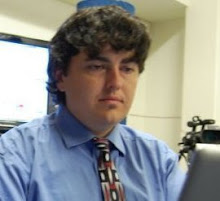Legendary director pulls a Woody scrambling to keep up
The Rumpled Critic
By David Giarrizzo
Shine A Light provides a welcome glimpse into the Stones' world at this advanced stage in their career, and continues Scorsese's obsession (No Direction Home, The Last Waltz) with documenting some of the most influential characters in rock & roll.
The music of the Rolling Stones has lit up the soundtracks to so many Martin Scorsese films; "Gimme Shelter" has appeared in no less than three of his features – Goodfellas, Casino and The Departed). It's little surprise to find the director teaming up with the legendary rockers for this concert recording.
Shine A Light begins with a few glimpses of the preparation that went into the recording of the show, which was staged over two nights in 2006 at New York's Beacon Theater Broadway, which opened in 1928. Scorsese makes the ritualized concert play like an opera, beginning with ten minutes of behind-the-scenes madness preparatory to filming the concert that works as a comic introduction of the characters (including Scorsese, doing his best Woody Allen). Guitarist Keith Richards is like the character actor who slowly, inevitably takes over the movie from the supposed star without ever leaving the sidelines. In fact, there is a point where he simply crouches down at the front of the stage like a gargoyle and the camera lingers as if to say, "You okay, mate?"
Scorsese opens the movie by suggesting the tensions that can flare up when great minds – his and Jagger's, that is – collide. We hear Jagger, a disembodied voice on the phone, expressing his concerns about the problems of filming a live performance, as Scorsese, either vaguely annoyed or feigning annoyance for the camera, responds by raising his caterpillar eyebrows. Scorsese wants lots of cameras and needs lots of lights; Jagger doesn't want anything to detract from the performance. Scorsese also has a discussion with his lighting director about the amount of heat from the halogen studio lights towering behind the audience in the balcony and roof. At one point, Scorsese screams at this poor schmuck: "I don’t want these lights burning Mick Jagger!"
Of course, later, in the middle of the show, Jagger turns his back to the lights and shields his eyes as he orates his displeasure to the nearest camera in his face. Scorsese doesn't budge. In fact, eighteen cameras — manned by the Oscar-winning likes of Robert Richardson, John Toll and Robert Elswit — seemingly gliding effortlessly about the stage like birds in flight.
Scorsese is anxious to see the set list so he can plan ahead; Jagger assures him it will be ready – an hour or so before the band goes onstage. Will they be able to pull their "Hey, kids, let's put on a show!" act together in time? As it was a benefit for the Clinton Foundation, Bill and Hillary Clinton were in attendance, along with Hillary's mom, and before the show the band comes out for a meet-and-greet. It's a kissy-face moment, except for the way Wood greets Hillary's mother. He’s just a nice guy, you can tell..
Almost voyeuristically, the cameras capture the most intimate spaces, like Jagger going into heat with a backup singer in "She Was Hot," Keith Richards crying out in his husky pirate voice on "You Got the Silver," Ron Wood mastering the guitar like a wizard and the ever-cool Charlie Watts bringing the audience to their knees with his still steady beat. With each zoom, the player in focus’s instrument, be it guitar, drums or vocals, comes to life with the clever sound engineering. If it wasn’t so clean, I would think it was taken directly off the camera microphones, and not off a mixing board. The close-ups were so extreme, I think I saw the map to Greenwich Village on Mick’s face. And Keith, well, I stopped counting his crow’s feet ten years ago. Do you think Anne Rice is a big Stones fan?
Jagger, in performance here, is pretty wooden: His rendering of "As Tears Go By" is clipped, exact, cautious, the words turned into a Hooked on Phonics session. Jack White looked like a kid at the Wonka Factory singing along side with Mick on "Loving Cup," and Christina Aguilera once again goes over the top, out-vamping even King Mick on "Live With Me." The best part is blues legend Buddy Guy on "Champagne & Reefer" – who was in the recording studio when the Stones visited Chicago's Chess Records during their first U.S. tour in 1964 – fits a little better with the music and holds down one of the longest shots in the film by simply staring into the camera.
Short pieces of vintage interview clips are salted in throughout; young Mick Jagger saying he thought the band might be able to last at least another year, yet, without batting an eyelash, assures the interviewer that he‘ll be doing this well into his Sixties. These little comic interludes lend some context to the performance as brief asides between songs, though they never threaten to turn the proceedings into some dreary rockumentary.
Monday, June 9, 2008
Subscribe to:
Post Comments (Atom)

No comments:
Post a Comment